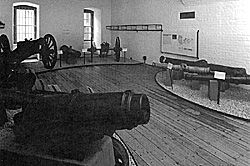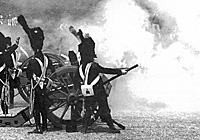Since the reign of Henry VIII, the Tower of London has been Britain's weapon storehouse. The Board of Ordnance operated from there to dispense
all manner of military stores to Britain's Navy and Army. The Board also
kept obsolete items as objects of curiosity which formed the basis for
what became the Tower Armouries, now called the National Museum of Arms
and Armour. Recently, the Royal Armouries began a 42.5-million pound
[approx. $90 million US] project in Leeds in the north of Britain for the
purpose of displaying more of the collection of weapons and armour which
the Armouries had accumulated over the years.
What is less well known is that since 1995, the Royal Armouries also
operate a third site in the shape of a Victorian Fort to house the
artillery branch of the Arms and Armour collection.
The site is known as Fort Nelson and is one of a number of forts which
exist on top of Portsdown Hill near Portsmouth in Hampshire,
approximately an hour and a half south from London.
Fort Nelson was built in the 1860's as part of a program to protect
Britain's most important naval base from the possibility of attack by
the French, then under the leadership of Napoleon III. Fort Nelson was
built as one element in a defensive ring around Portsmouth and its guns
face towards the land.
The period in which the fort was built was a transitional one; the end
of the smooth-bore period of artillery weapons was in sight and the
introduction of new rifled breech-loading weapons meant that
fortifications were no longer to be built on the sea front but had to be
built on the dominating heights above the town. Its design was
influenced by Prussian theorists on artillery fortification who in turn
were influenced by their experiences during the Napoleonic Wars.
Therefore the site itself has much of interest to the historian; its
extensive magazine tunnels, caponier and ramparts still retain many of
the features which were the state of the art in the 1860's.
The most important part of the museum is its collection. On display at
Fort Nelson there is an array of artillery which spans the early period
of wrought iron gun construction to sections of the Iraqi Supergun taken
in Desert Storm.
Napoleonic Artillery
In terms of Napoleonic artillery there is much to see. Starting with
field artillery the museum houses several French pieces, and one of the
finest is the 12-pounder Gribeauval cannon which is in the 18th Century
gallery. The piece was cast, according to the French Revolutionary
dating system, in the 3rd year of the Republic, that is 1794. In common
with other guns of this type it was individually named; in this case it
is called "Voltaire." The right hand side of the barrel bears shot
damage which is thought to have been sustained at Waterloo. The gun
carriage is original and gives us a great deal of information on
construction methods during the period. It has two sets of trunnion
bearings so that while being transported it can be positioned on the
rear pair and when coming into action the barrel would be repositioned
on the front pair.
Napoleon's invasion plans for Britain relied heavily on the notion that
large numbers of troops would be transported across the Channel on
barges or prames as they were known. For defensive purposes each prame
was armed with twelve 9-foot 24-pounder bronze cannon, and the gunners
acted as oarsmen. The Royal Armouries possesses one of these guns that
are slightly modified to fit in the confines of the barge. Cast in 1806
at Avignon, the breech of the gun and the base ring has been flattened
on each side, presumably for fitting into the ship. This particular gun
"La Victoire" was part of the armament of the Ville de Lyon which was
captured by HMS Naiad on 21 September, 1811.
There are a variety of other French weapons from the period including
6-pounders of the later Système An XI and 6-inch howitzers of the
Gribeauval system.
 18th century gallery. Foreground: 24pdr carronade. Background: French 12pdr and Dutch 4pdr, both captured at Waterloo.
18th century gallery. Foreground: 24pdr carronade. Background: French 12pdr and Dutch 4pdr, both captured at Waterloo.
The collection is unique in that
it contains many items of artistic
and technical interest all housed
in an historic ancient monument.
British weapons are also represented, both for land and sea service. The collection contains a number of brass 3-, 6- and 9-pounder guns for land service, some of which have very ornate ciphers and badges, normally of the monarch and Master General of the Ordnance.
 At right, members of the Guard Imperial Living History Group fire their reproduction artillery pieces at the Fort Nelson Grand Artillery Day, 1997
At right, members of the Guard Imperial Living History Group fire their reproduction artillery pieces at the Fort Nelson Grand Artillery Day, 1997
One of the best examples of British ordnance is the 12-pounder bronze gun and carriage of 1798. It was cast by John and Henry King who were both founders at the Royal Brass Foundry in Woolwich throughout the Napoleonic Wars. Henry King was the last Master Founder at Woolwich until 1818. The Congreve block trail carriage has been heavily rebuilt but is still equipped with the original metal fittings.
Carronades
In terms of sea service weapons Fort Nelson holds a variety of carronades, from 12- to 68-pounders and cast iron guns used on both sides in the Napoleonic naval campaigns. Additionally, associated with the raid on Copenhagen are two fine bronze Danish guns taken during that battle in 1807. They were presented by the Duke of Wellington to Captain Phillimore of the Royal Navy in 1811.
Although the campaigns of the coalitions against Napoleon were in the main fought out in Europe, there were interesting side-shows in Egypt, India and the Dutch East Indies. The campaigns of Sir Arthur Wellesley (later Duke of Wellington) in India produced a rich cache of trophies in the form of highly decorated gun barrels, two of which are on display in the art gallery at Fort Nelson. Indian gun founders went to great pains to decorate and embellish their guns and although very different in style both have a tiger's head as the muzzle. The longer of the two has its trunnions considerably to the front of the gun and it may be that it was designed to be positioned in a deep embrasure. Both of these guns were taken at Ahmednuggar in Bombay province, India in 1803.
Similarly the attack on Java in 1811 commanded by Major General Auchtermuchty yielded a number of bronze guns one of which is an impressive 42-pounder thought to be from the country of Palembang in southern Sumatra.
The above covers only a tiny fraction of the artillery equipment on show at Fort Nelson and enthusiasts will find guns from earlier periods in abundance. The collection is unique in that it contains many items of artistic and technical interest all housed in an historic ancient monument. For visitors with a dual interest in artillery and Napoleonic history this is a must-see site.
To get to Fort Nelson by road take the M27 to Portsmouth and turn off at junction 11. The Fort is sign-posted from there on. By train, the nearest station is Portchester and a short taxi ride will take you to the top of Portsdown Hill.
Back to Table of Contents -- Napoleon #12
Back to Napoleon List of Issues
Back to MagWeb Master Magazine List
© Copyright 1998 by Emperor's Press.
This article appears in MagWeb (Magazine Web) on the Internet World Wide Web.
The full text and graphics from other military history magazines and gaming magazines are available at http://www.magweb.com